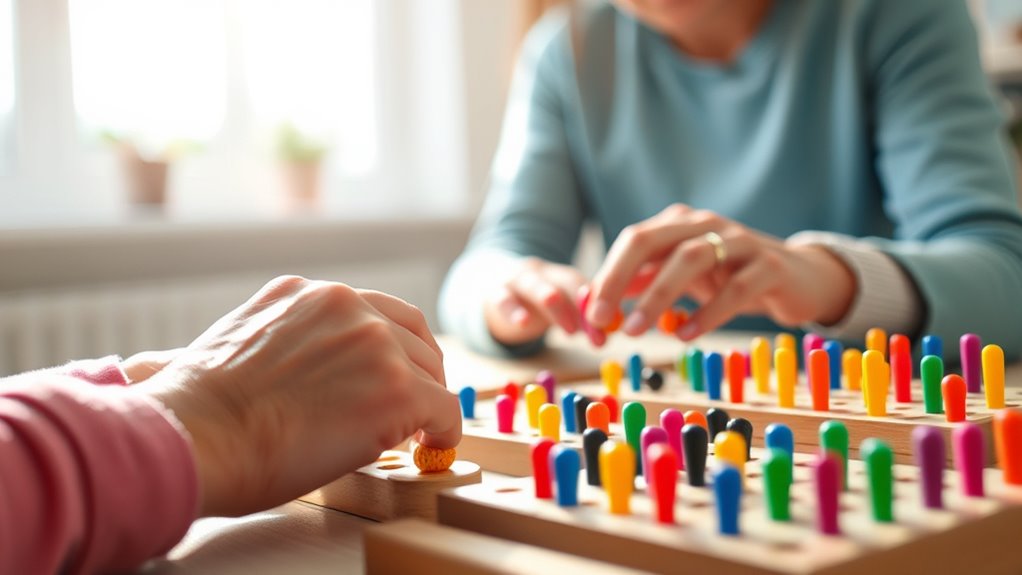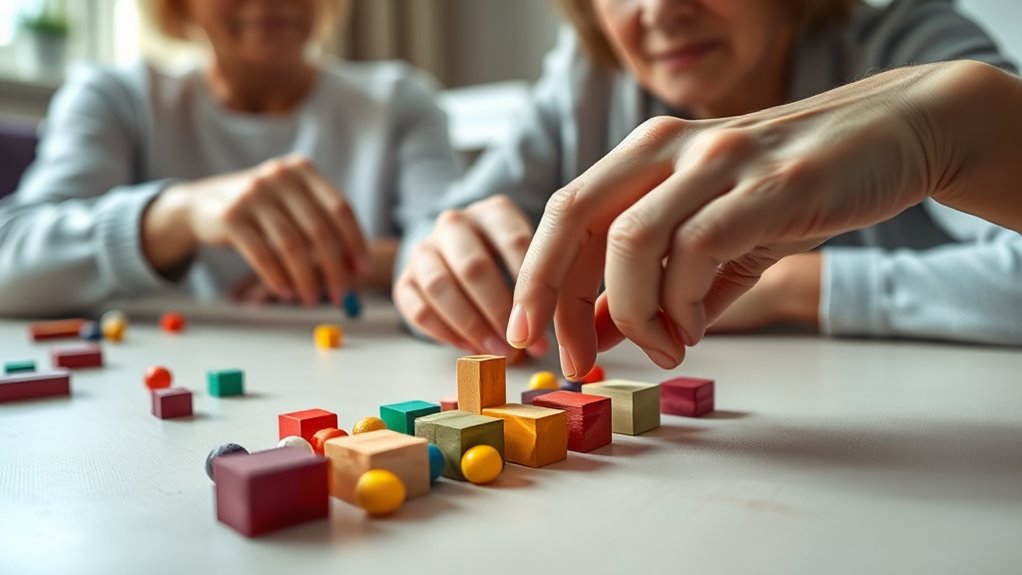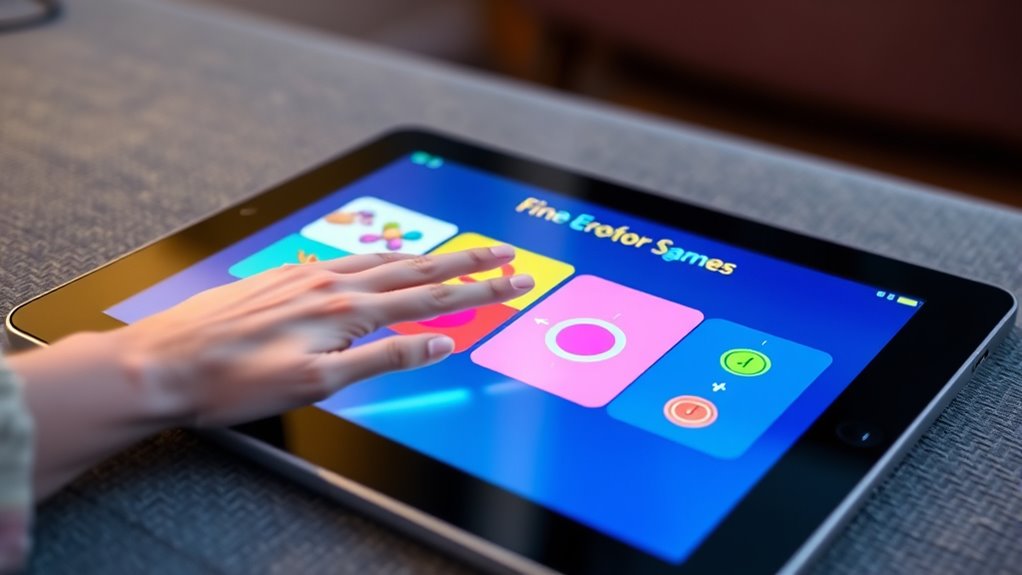Engaging in fine-motor skill games after a stroke helps you regain hand strength, coordination, and neural connection, which supports your recovery. Activities like balloon tennis, card sorting, puzzles, bead threading, and crafts make therapy enjoyable and boost motivation. Incorporating these into daily routines or using digital tools can enhance progress. Keep practicing these fun, targeted exercises, and you’ll discover more ways to tailor your recovery journey as you continue exploring.
Key Takeaways
- Incorporate engaging activities like balloon tennis and card sorting to rebuild dexterity and coordination post-stroke.
- Use game-based tasks such as puzzles, bead threading, or virtual reality for motivation and neural recovery.
- Tailor activities to individual abilities, integrating preferred tools to enhance enjoyment and adherence.
- Transform daily routines into playful exercises to promote consistent practice and functional skill improvement.
- Utilize digital apps and gamified tools to track progress and maintain motivation during fine-motor rehabilitation.
Benefits of Fine-Motor Activities in Stroke Rehabilitation

Engaging in fine-motor activities during stroke rehabilitation offers several important benefits. These exercises help you regain dexterity and strength in your hands and fingers, making daily tasks easier. They also promote neural recovery by encouraging brain reorganization, which can speed up your progress. As you practice, you’ll develop better hand-eye coordination, precision, and control—crucial for completing activities like writing, dressing, or cooking. Fine-motor activities can boost your confidence, reducing frustration and increasing motivation to continue therapy. Additionally, these exercises stimulate brain plasticity, supporting overall cognitive function. The role of color accuracy in visual feedback can enhance the effectiveness of these exercises, leading to better outcomes. Incorporating visual feedback mechanisms can optimize your training and improve skill retention. By actively participating in targeted activities, you’re not only working towards physical recovery but also rebuilding independence and quality of life after a stroke.
Classic Games to Enhance Hand-Eye Coordination

Playing balloon tennis can boost your hand-eye coordination while keeping the activity fun. Card sorting challenges push you to improve fine motor control and cognitive skills simultaneously. These classic games offer simple ways to make your rehabilitation engaging and effective. Incorporating electric bikes into your routine can also provide low-impact exercise that supports motor skill recovery. Engaging in activities that promote neuroplasticity can further enhance recovery outcomes. Additionally, participating in structured rehabilitation exercises tailored to your needs can optimize your progress. Monitoring your website performance metrics can help track your improvement and motivate continued activity. Exploring specialized therapy tools designed for fine motor rehabilitation can further augment your recovery journey.
Balloon Tennis Fun
Have you ever tried balloon tennis to boost hand-eye coordination after a stroke? This simple game involves using your hands or paddles to keep a balloon airborne, mimicking the rhythm of tennis. It’s an engaging way to practice controlled movements and improve timing. You can play solo or with a partner, making it adaptable to your comfort level. The lightness of the balloon reduces frustration, encouraging gentle, precise motions. As you hit the balloon back and forth, you’ll develop better coordination, strength, and focus. Plus, it’s fun and easy to set up anywhere—just inflate a balloon and find a nearby surface or open space. Balloon tennis offers a playful, effective way to rebuild your fine-motor skills while enjoying the process.
Card Sorting Challenges
Card sorting challenges are a straightforward yet effective way to enhance hand-eye coordination after a stroke. These activities require you to match, categorize, or organize objects based on color, shape, or size. As you pick up and place cards or items, you engage your visual and motor skills simultaneously. Start with simple tasks, like sorting cards by color, then progress to more complex arrangements. This process helps rebuild your fine-motor control and improves your ability to perform daily tasks. Keep your movements steady and deliberate, focusing on accuracy over speed. Regular practice with card sorting challenges can boost your confidence and coordination over time, making everyday activities easier and more manageable. Plus, it’s a fun way to stay motivated during your recovery journey.
Digital Apps and Virtual Reality for Motor Skill Recovery

Digital apps and virtual reality create immersive environments that make motor skill recovery engaging and motivating. Interactive game designs keep you actively involved, helping improve coordination and strength. With progress tracking technology, you can monitor your improvements and stay motivated throughout your rehabilitation journey.
Immersive Virtual Environments
Immersive virtual environments, including digital apps and virtual reality (VR) systems, have become increasingly popular tools for stroke rehabilitation focused on fine-motor skill recovery. These environments allow you to engage in realistic, interactive tasks that mimic everyday activities. You might find yourself reaching out to grasp virtual objects, manipulating tools, or maneuvering through immersive scenes. The experience often involves:
- Moving through vivid, 3D landscapes
- Interacting with virtual objects that respond to your touch
- Practicing precise finger and hand movements
- Receiving real-time feedback on your actions
- Participating in engaging, game-like scenarios
These systems help motivate you to practice consistently while providing tailored challenges that adapt to your progress. They create an engaging, safe space to rebuild fine-motor skills with visual and tactile cues.
Interactive Game Designs
Interactive game designs in digital apps and virtual reality platforms transform stroke rehabilitation by making exercises more engaging and personalized. These designs adapt to your specific needs, adjusting difficulty levels and providing real-time feedback to keep you motivated. By incorporating intuitive controls and immersive visuals, they turn routine exercises into enjoyable activities that encourage consistent practice. You won’t feel like you’re doing therapy; instead, you’ll be immersed in tasks that resemble everyday activities, helping develop fine-motor skills naturally. Many platforms include gamified elements, such as scoring and progress rewards, which boost your motivation. The interactive nature of these designs also enables you to focus on movement quality, promoting better motor control and recovery outcomes. Overall, they make your rehab journey more effective and less monotonous.
Progress Tracking Technology
Progress tracking technology plays a crucial role in stroke rehabilitation by providing real-time data on your motor performance. It helps you see how well you’re improving, motivates you to keep going, and allows your therapists to tailor your exercises. Digital apps and virtual reality tools monitor your hand movements, grip strength, and coordination with precision. Imagine wearing a VR headset as you reach for virtual objects, feeling your progress unfold instantly. You might see:
- Visual feedback of your hand movements on a screen
- Metrics showing your grip strength and dexterity
- Progress charts tracking improvements over sessions
- Immediate correction prompts to refine your technique
- Virtual rewards motivating continued effort
This technology makes your recovery more engaging and personalized, accelerating progress toward restoring fine-motor skills.
DIY Crafts and Bead Threading for Dexterity

Engaging in DIY crafts and bead threading can considerably improve fine-motor skills after a stroke. These activities require precise hand movements, coordination, and focus, helping rebuild dexterity. As you practice threading beads onto string or creating small craft projects, you strengthen finger muscles and enhance hand-eye coordination. To illustrate, here’s a table showing different craft options:
| Craft Type | Materials Needed | Skill Focus |
|---|---|---|
| Bead Threading | Beads, string | Hand control, precision |
| Paper Quilling | Colored paper strips | Fine motor coordination |
| Knitting/Crochet | Yarn, needles | Finger strength, coordination |
| Painting/Decorating | Brushes, paints | Fine motor control |
These activities are adaptable for all skill levels, making them effective tools for recovery. Sensory engagement in these activities can further enhance neural connections and aid in the rehabilitation process. Incorporating structured practice can accelerate progress and motivate continued effort. Additionally, understanding the importance of neuroplasticity can help in designing effective therapy routines, which is crucial for restoring fine-motor skills. Developing a consistent routine can also lead to more steady improvements over time.
Puzzles and Sorting Tasks to Improve Precision

Puzzles and sorting tasks are effective tools for enhancing precision and hand-eye coordination after a stroke. They challenge you to focus on small details and control your finger movements with accuracy. As you manipulate puzzle pieces or sort objects, you engage muscles and improve fine motor skills. Imagine:
- Picking up tiny puzzle pieces with steady fingers
- Aligning and fitting pieces into precise spots
- Sorting coins or buttons by size, shape, or color
- Placing small objects into matching containers
- Connecting dots or completing patterns with careful movement
These activities help retrain your brain to coordinate your hand and eye movements. Incorporating sensory feedback into these tasks can further enhance coordination and engagement. Regular practice of fine motor exercises also supports neuroplasticity and recovery. Engaging in neuroplasticity-focused activities can accelerate progress and improve functional outcomes. Consistently practicing puzzles and sorting tasks builds confidence and gradually restores your ability to perform daily fine-motor tasks with greater ease. Pinball machines often require similar precise movements and can serve as engaging tools for fine-motor skill development.
Incorporating Play Into Daily Routine Practices

Building on the improvements gained from puzzles and sorting tasks, integrating playful activities into your daily routines can make rehabilitation more enjoyable and sustainable. Simple actions, like turning chores into games, boost motivation and consistency. For example, challenge yourself to button shirts faster or pick up small objects during breakfast. Incorporate music or timers to add an element of fun and competition. Use everyday items—like squeezing sponges or handling utensils—to practice fine motor skills without extra effort. Setting small, achievable goals throughout the day helps you stay engaged and track progress. The key is to embed play into routine tasks so that practicing your skills becomes natural and less like a chore, increasing the likelihood you’ll stick with it long-term. Additionally, leveraging mindfulness techniques like deep breathing or visualization can reduce frustration and enhance focus during exercises, making practice sessions more effective. Incorporating dog names that evoke comfort or motivation can also provide emotional support during rehabilitation. Leveraging digital resources like apps and online communities can provide motivation and support throughout your rehabilitation journey. Moreover, understanding the importance of a productive environment can also help optimize your practice sessions by reducing distractions and promoting focus. Creating a structured routine can further enhance consistency and help establish effective habits during recovery.
Choosing the Right Activities for Individual Needs

Choosing the right activities for your individual needs requires understanding your specific strengths, challenges, and goals. Reflect on what movements feel comfortable and where you struggle. Consider your motivation—what excites you? Your daily routines and available time also matter. To tailor activities effectively, think about:
- The level of difficulty you can handle comfortably
- Hand and finger movements you want to improve
- Types of activities that keep you engaged
- Materials or tools you enjoy using
- Your long-term recovery goals
- Incorporating physical activity into your routine can support overall well-being and recovery. Exploring crochet styles for locs can offer creative ways to develop fine-motor skills while also providing a relaxing activity. Additionally, selecting top mattress toppers that suit your comfort preferences can enhance your overall sleep quality, which is vital for recovery.
Frequently Asked Questions
How Can Caregivers Motivate Stroke Patients to Engage in Fine-Motor Games?
You can motivate stroke patients to engage in fine-motor games by making activities fun and relevant to their interests. Encourage them with positive feedback and set achievable goals to boost confidence. Demonstrate enthusiasm and participate alongside them to create a supportive environment. Offering small rewards or celebrating progress also helps maintain motivation. Remember, patience and encouragement are key to helping them enjoy and benefit from these exercises.
Are There Safety Concerns With Specific Fine-Motor Activities for Stroke Survivors?
Think of activities as a double-edged sword—you want to sharpen skills, but safety must be your shield. For stroke survivors, some fine-motor activities might pose risks like strain or frustration if not tailored properly. Always assess their abilities, avoid sharp tools or small parts that could be swallowed, and supervise closely. Stay vigilant to turn these activities into safe, empowering stepping stones rather than hazards on their recovery journey.
What Are Signs of Fatigue or Overexertion During Fine-Motor Exercises?
When you’re doing fine-motor exercises, watch for signs of fatigue or overexertion. You might notice increased muscle weakness, tremors, or a feeling of exhaustion. Your hands could shake more, or you might feel pain or discomfort. If you start to feel dizzy, nauseous, or overly tired, stop immediately. Rest is essential to prevent injury or setbacks, so listen to your body and take breaks as needed.
How Often Should Fine-Motor Activities Be Incorporated Into a Rehabilitation Plan?
Think of your rehab plan as a delicate garden that needs regular tending. You should incorporate fine-motor activities daily, but start with short sessions—about 10 to 15 minutes—and gradually increase as your strength and coordination improve. Consistency is key, so aim for several sessions a week. Always listen to your body, and rest if you feel fatigue creeping in—your progress will flourish with patience and care.
Can Fine-Motor Games Be Adapted for Severe Motor Impairments?
You can adapt fine-motor games for severe impairments by simplifying tasks, reducing required movements, and using assistive devices. Focus on small, achievable movements to build confidence and gradually increase complexity. Incorporate sensory feedback and guarantee activities are engaging. Customizing games to your abilities helps promote motivation and progress, making rehabilitation more effective and enjoyable despite significant motor challenges.
Conclusion
By embracing these engaging activities, you paint a vivid canvas of progress and resilience. Each game, craft, or puzzle becomes a brushstroke, restoring your hand-eye coordination with patience and joy. As you weave play into daily routines, you cultivate a landscape of regained dexterity and confidence. Remember, every small movement is a step toward reclaiming your independence, transforming recovery into a journey of vibrant renewal and empowering self-discovery.









